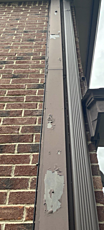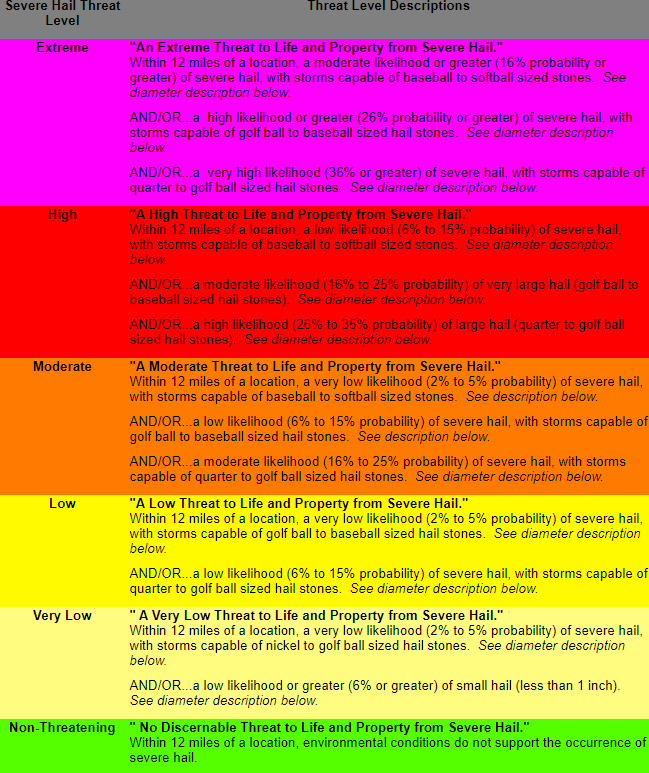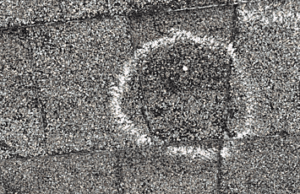
Hail damage on a residential gutter.
What Kind of Damage Can Hail Do?
Everyone knows you don’t want to be caught in a hail storm. Little blocks of ice falling out of the sky sounds pretty painful! Your safest bet is to make sure there’s a roof over your head. But what about your roof? What kind of damage can hail do to your roof? Can it damage anything else I should know about? (See gutters above.) The answer to this all depends on what size of hail you’re dealing with, how much hail is falling, and what your roof is made of. So let’s dive into hail sizes and take a look at what they can do.
Aw Hail No

National Weather Service hail severity chart.
The National Weather Service categorizes hail in two ways. First, hail is described by threat level. This ties into the size of the hail but also in the likelihood of large hail being prevalent in the storm system. As the severity increases, so do the chances of large, heavy hail making an appearance. Hail is divided into 6 severity categories and 4 size categories. We’ll dive into the sizes of hail and the threat they likely pose to your property.
Sizes of Hail and Potential Damage
- Small: small hail is less than 1″ in diameter, often described as being between pea and quarter sized hail
- Small hail likely shows up in non-threatening, very low threat, and low threat storms.
- Damage: this size hail should not cause much damage to your home. However, if you notice that most of the hail near you was closer to 1″, it is a good idea to give us a call for a quick inspection.

Tough to see hail damage on a client’s shingle roof.
- Large: large hail is from 1′ to 1 3/4″ inches in diameter, described as quarter to golf-ball sized hail
- Large hail is prevalent in moderate and high threat hail storms.
- Damage: hail of this size definitely warrants a roof inspection post-storm. Often the damage is difficult to see but shingles can lose essential durability and hail this size can create unwanted divots. This size of hail can also damage gutters and downspouts, essential elements to controlling precipitation.
- Very large: Very large hail is between 1 3/4″ and 2 3/4″ in diameter, described as being between golf ball and baseball sized
- Very large hail is capable of severe damage and is often found in high threat and extremely threatening storms.
- Damage: hail of this size is noticeable, as is the damage it creates. Be sure to have a professional take a look at your roof after hail of this size strikes.
- Giant: Giant hail is anything larger than 2 3/4″ in diameter, often described as being the size of grapefruits or softballs.
- Giant hail is found in extremely threatening storms and is luckily very rare.
- Damage: It goes without saying that this is the most destructive type of hail you may come across, especially in the plains of Texas. If hail of this arrives, stay safe and call us.
What Kind of Damage Can Hail Do?
Naturally, hail is capable of creating very visible damage like dents or holes in gutter systems, but small, low threatening hail storms can cause damage that is much harder to see. Falling frozen water can not only damage the shingles on your roof (or the metal) but can cause divots in the underlying layers as well. The outermost layer of your roof protects so much. It creates a watertight barrier and a solid cover for your home and the many layers that sit beneath the shingles. It is important to have a roof inspection completed after a major weather event like a hailstorm. Damage to underlying layers is hard to see with the untrained eye, so trust our decades of experience to let you know how your roof is doing.
Conclusion
Hail can be a scary element to sudden thunderstorms. Keep yourself safe during these events by taking cover and waiting for it to pass. Once your roof has done its job of keeping you safe, call Roof Experts. Our team of knowledgeable technicians will diagnose any problems caused by hail and can help you decide the next step for keeping your roof in great shape.
Roof Experts is here for all of your commercial roofing needs. Contact us today and let us know what we can do for you!



